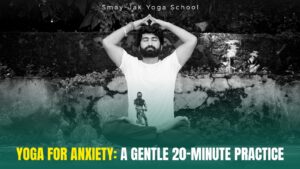Injuries are a significant concern in the yoga community, and it’s essential for both practitioners and teachers to stay aware of the potential risks. By cultivating awareness and tuning inward, we can prevent many physical injuries. Trusting and listening to our bodies is at the heart of yoga practice. Our bodies are naturally intuitive, and recognizing this helps us avoid injury by respecting our limits and silencing external distractions.
As teachers, we have a responsibility to guide our students toward a balance between effort and ease, without letting our egos get in the way. In yoga, we strive for balance—Sthira-sukham-asanam—but it’s easy to push too hard and become vulnerable to injuries.
Understanding Yoga Injuries
The practice of asanas has evolved from a one-on-one tradition to large group classes, both in studios and online. In these settings, injuries can occur when individual attention is limited, making it vital to stay attuned to our bodies. Repetitive incorrect postures, lack of awareness, and insufficient warm-up routines are common causes of injury.
Lower back pain is a frequent issue, often due to rounding the spine during forward folds, straining the muscles. Those with hypermobility are at risk of injuring their ligaments and tendons due to over-flexibility. Injuries can also affect the knees, shoulders, hamstrings, wrists, and hips, especially if core muscles are not engaged. Advanced poses like Chaturanga and Padmasana, when performed incorrectly, can lead to injuries.
Beyond asanas, a stress-fueled lifestyle contributes to injuries both on and off the mat. This blog aims to highlight how injuries can be prevented for both practitioners and teachers.
1. Setting the Tone
As a teacher, it’s crucial to address the topic of injuries at the start of each class. Encourage students to stop if they feel pain, fatigue, or confusion. Asking about recent injuries or surgeries can help you guide them appropriately. Offering alternative poses, like Child’s Pose, allows students to take a break and rejoin the class when they’re ready. Practitioners should also know their limits and take responsibility when their bodies need rest.
2. Warm-Up
A proper warm-up routine is essential before starting a physical yoga practice. Warming up enhances muscle coordination, reaction time, and blood flow, preparing the body for increased activity and mobility. Gentle Sun Salutations are an effective way to prepare for the asanas that follow.
3. Acceptance
Acceptance is key in yoga, both for teachers and students. While we must take steps to prevent injuries, it’s important to acknowledge that injuries can happen in daily life, and the line between yoga injuries and everyday injuries is often blurred. For example, lower back pain from lifting heavy objects or an ankle sprain from running can be aggravated during yoga practice. Understanding this helps us approach yoga with realism and caution.
4. Provide Alternatives
As a teacher, identify what works for your students and offer props or adjustments as needed. If a student isn’t ready for a pose, suggest alternatives or regressions. For example, if a student can’t perform Chakrasana, they can stay in Setu Bandhasana. Over time, drills can help them progress and build confidence in more advanced poses.
5. Tailor-Made Classes
Design your classes to meet the needs of your students, balancing enthusiasm with gradual progression. Encourage your students to progress at their own pace, avoiding the temptation to push them beyond their limits. Yoga is a journey, and it’s important to practice over perfection in the long run.
6. Slow and Steady
Rapid changes can overwhelm the body, so it’s important to introduce corrections gradually. Teachers should also be cautious when assisting flexible students to avoid causing injury. Students should communicate with their teachers when they need adjustments or help. Ultimately, practitioners know their bodies best, so always listen to your body first.
7. Comparison is a Thief of Joy
Remind yourself and your students that yoga is a personal journey, and no two bodies are the same. Avoid comparing yourself to others, as this can undermine the purpose of yoga. Emphasizing the uniqueness of each body helps create a more aware and judgment-free practice environment.
8. Assess Your Dosha
Understanding your students’ doshas can be a valuable tool in guiding their practice. Vata practitioners benefit from meditation and therapeutic yoga, while Pitta practitioners, who are prone to inflammation, need to be cautious to avoid injury. Kapha practitioners, who are less flexible, require time and practice to advance in their asanas. Recognizing the influence of doshas can help tailor yoga practices to individual needs.
9. Every Practice is Unique
The quote by Sri B.K.S. Iyengar, “My body is my temple, and asanas are my prayers,” resonates deeply in yoga practice. Each day’s practice is unique, reflecting the dynamic nature of our bodies. Some days we feel energized, while others we may feel tired or disappointed. Just as prayer isn’t measured by success, neither should our yoga practice be. Start with Surya Namaskara and standing asanas, and if your body still feels tired, accept it and return the next day. This mindset shift can help prevent injuries and create a more fulfilling practice.












